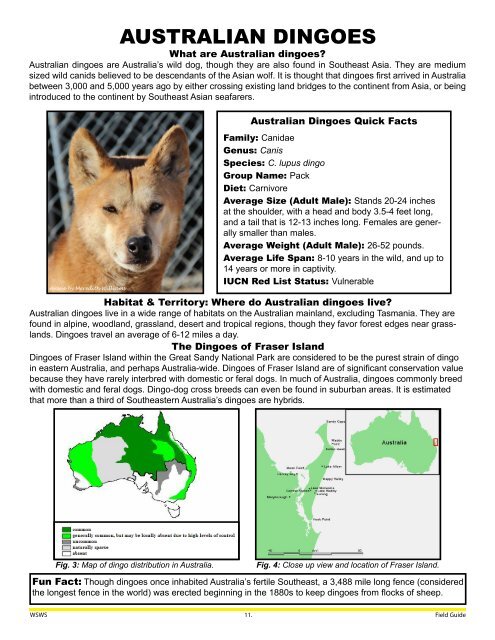Wild Spirit Wolf Sanctuary Educational Field Guide
Wild Spirit Wolf Sanctuary’s Student Field Guide provides readers with in depth details on the species of wild canids our Sanctuary houses, including their physical characteristics, behaviors, similarities and differences, territory, endangered species status, and the important functions these animals play in their native ecosystems. We hope you have a howling good time reading our Field Guide!
Wild Spirit Wolf Sanctuary’s Student Field Guide provides readers with in depth details on the species of wild canids our Sanctuary houses, including their physical characteristics, behaviors, similarities and differences, territory, endangered species status, and the important functions these animals play in their native ecosystems. We hope you have a howling good time reading our Field Guide!
You also want an ePaper? Increase the reach of your titles
YUMPU automatically turns print PDFs into web optimized ePapers that Google loves.
AUSTRALIAN DINGOES<br />
What are Australian dingoes?<br />
Australian dingoes are Australia’s wild dog, though they are also found in Southeast Asia. They are medium<br />
sized wild canids believed to be descendants of the Asian wolf. It is thought that dingoes first arrived in Australia<br />
between 3,000 and 5,000 years ago by either crossing existing land bridges to the continent from Asia, or being<br />
introduced to the continent by Southeast Asian seafarers.<br />
Aussie by Meredith Williams<br />
Australian Dingoes Quick Facts<br />
Family: Canidae<br />
Genus: Canis<br />
Species: C. lupus dingo<br />
Group Name: Pack<br />
Diet: Carnivore<br />
Average Size (Adult Male): Stands 20-24 inches<br />
at the shoulder, with a head and body 3.5-4 feet long,<br />
and a tail that is 12-13 inches long. Females are generally<br />
smaller than males.<br />
Average Weight (Adult Male): 26-52 pounds.<br />
Average Life Span: 8-10 years in the wild, and up to<br />
14 years or more in captivity.<br />
IUCN Red List Status: Vulnerable<br />
Habitat & Territory: Where do Australian dingoes live?<br />
Australian dingoes live in a wide range of habitats on the Australian mainland, excluding Tasmania. They are<br />
found in alpine, woodland, grassland, desert and tropical regions, though they favor forest edges near grasslands.<br />
Dingoes travel an average of 6-12 miles a day.<br />
The Dingoes of Fraser Island<br />
Dingoes of Fraser Island within the Great Sandy National Park are considered to be the purest strain of dingo<br />
in eastern Australia, and perhaps Australia-wide. Dingoes of Fraser Island are of significant conservation value<br />
because they have rarely interbred with domestic or feral dogs. In much of Australia, dingoes commonly breed<br />
with domestic and feral dogs. Dingo-dog cross breeds can even be found in suburban areas. It is estimated<br />
that more than a third of Southeastern Australia’s dingoes are hybrids.<br />
Fig. 3: Map of dingo distribution in Australia.<br />
Fig. 4: Close up view and location of Fraser Island.<br />
Fun Fact: Though dingoes once inhabited Australia’s fertile Southeast, a 3,488 mile long fence (considered<br />
the longest fence in the world) was erected beginning in the 1880s to keep dingoes from flocks of sheep.<br />
WSWS 11. <strong>Field</strong> <strong>Guide</strong>


